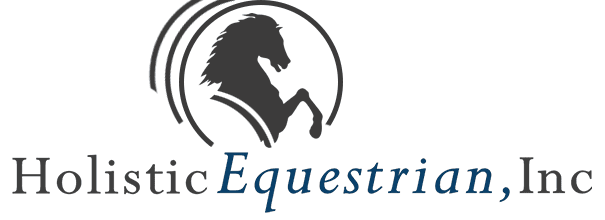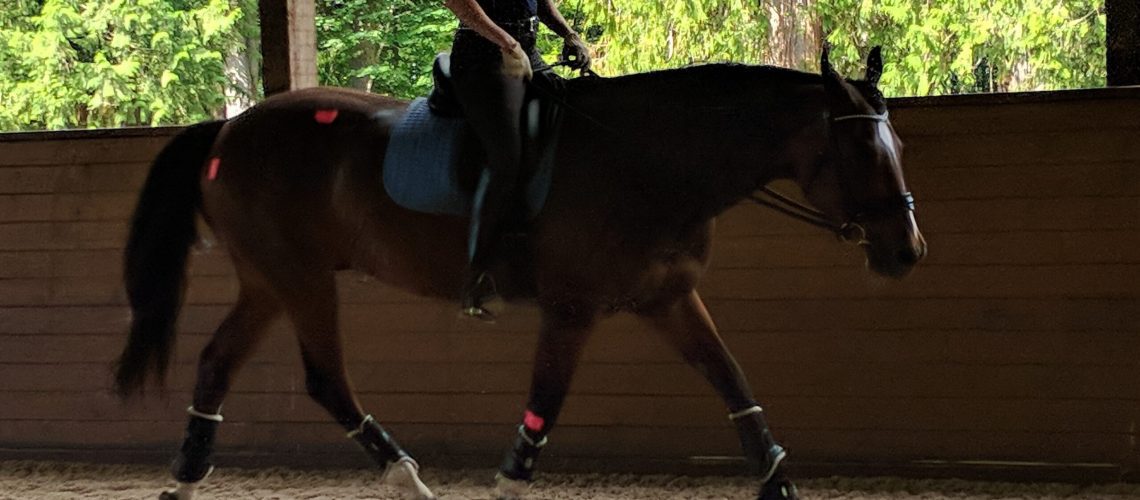This weekend I had the thoroughly delightful opportunity to attend a symposium featuring Sabine Shut-Kerry, sponsored by the Equestrian’s Institute and hosted by Veluto Equestrian Center. It was extremely educational and refreshingly “real.” By that I mean, Ms. Shut-Kerry found the weaknesses in all the horses and gave the riders practical exercises to use at home to strengthen those weaknesses using the Training Scale as the basis for improvements. She focused on improving the rhythm and relaxation in every horse, from the baby green 4 year old, to the horses currently competing at FEI. Relaxation leading to greater suppleness was the top priority, and resulted in improved straightness, impulsion, and engagement appropriate to the level of each horse.
Relaxation is also my #1 priority in my own training program, and it is perhaps the most crucial element to my ability to bring horses from career threatening unsoundness, to true long-term soundness and confidence. I sometimes face pushback for taking the time to focus on it. Even Ms. Shut-Kerry asked the question, “Don’t you all find this boring to watch?” to which, to my great delight, the crowd emphatically said “NO!” Throughout the weekend I was brought again and again to the realization that we (the Dressage community at large) no longer seem to truly understand how to apply this fundamental principle to our daily training, and I started thinking about how we can change that, and what we need to understand in order to make lasting changes in our training culture.
Perhaps the first thing we need to acknowledge is “Why” we should prioritize relaxation with our horses.
As a human health and fitness coach, I know that muscles strengthened through relaxation are stronger than those strengthened through tension. In fact, muscles worked in tension (working out faster, pushing harder, and lifting heavier) present a much higher instance of injury than muscles strengthened through lower impact methods such as yoga, Pilates, and other types of strength training that focus on proper form, frequent rest breaks and stretching.
Tension, which typically is triggered by hormones produced by the adrenal glands (the fight or flight response), produces the illusion of strength which doesn’t come from actual muscle strength, but the chemical reaction to epinephrine and norepinephrine. The reactions to these hormones in the body constitute what’s called the “extreme stress response” which allows for temporarily quicker and stronger reactions to perceived danger. This is critical to understand when we are dealing with prey animals that already have a heightened flight response.
So why is this important to understand? Because muscles that are used in this heightened state of tension, without actually being as strong as they may seem to be, are at a significantly greater risk of strain and tears. They are likely to stay in contraction, rather than go through the normal process of contraction and release, and thus put greater stress on tendons and ligaments. Because the horse is in a heightened state of fight or flight, they seem like they can work longer than their bodies can actually sustain. Over time and with repetitive stress, this will inevitably result in injuries to these soft tissues and can even result in muscle tissues becoming fibrous (due to scarring) and losing their proper function entirely. Working through tension results in gait abnormalities, asymmetries, and long-term physical pathology (such as osteoarthritis). This is largely why I have a job… because this happens so frequently that there is no lack for horses that need “physical therapy” to regain their athletic capacity and soundness. If we don’t want our horses to end up lame and injured, we need to make working in relaxation a top priority.
The next question is “how” do we do this? And, this is where I believe we have the most significant changes to make, because not only have to change our focus during training but we also have to change our “eye” for what’s good, and we have to change our entire training culture. The objective reality is that horses *are* prey animals, and they do get stressed and become tense when they are confused, become frightened, or when the work becomes more difficult. That is a perfectly normal and expected part of the learning process. The key is becoming aware of when that happens, and instead of ignoring it and pushing on, we address the cause of the tension before moving on to the next more difficult thing.
As trainers, we have to be willing to slow down and instead of pushing through tension to achieve a result, we need to give our horses time to understand what we’re asking and find relaxation within the exercises, instead of relying on their extreme stress responses to “make it happen.” We have to check ourselves Every.Single.Time we notice our horses developing tension in their work.
We may have to take a step back to something the horse finds easier to do, and/or be creative in our training to come at a difficult thing from a different direction, or in a different way – something Sabine Shut-Kerry demonstrated over and over throughout the weekend symposium. And that means we need to educate ourselves to have a toolbox full of these clever little tools that we can use to the benefit of our horses, so they don’t have to live with constant extreme stress in their jobs. We must prioritize relaxation of the muscles and the mind for our horses as we train them, in order to not only prevent injuries and give them the most resilient and athletic bodies possible, but also to give them the opportunity to actually enjoy their time with us.
Now, I hear you saying, “But Tammy, that makes the training take too long, and our clients won’t be happy with how long it’s taking to train their horses…” To which I ask, do you have time to rehab a suspensory injury? Or do your clients have the finances to provide their horses joint injections every few months? Because those two things are the inevitable outcomes of ignoring the relaxation of the horse and continuing to work through tension. Or do your clients have the desire to heal from an injury themselves because their horse dropped them in the dirt with a particularly violent spook or buck?
Sabine Shut-Kerry answered the time question by saying “Training Takes TIME.” If we are too impatient to train our horses in a way that gives them confidence and reduces physical and mental strain, then perhaps we need to re-evaluate our own values. If our clients are too impatient for us to train their horses in a healthy and confidence building way, then we need to educate them better. We need to develop and teach empathy for the sentient and sensitive creatures we are partnering with.
If, as horse owners we feel that we don’t have the patience or skills to foster relaxation in our horses as our priority, then the most ethical thing we can do is find someone to help us who can do this for our horses. If we work and have schedule restraints that only allows us and hour or two a with our horses each day, or only a few days a week, and we want to enjoy that time with them by doing “fun” things instead of doing “yoga” type exercises with our horses, then we need to give the horses that opportunity by putting them in a training program with someone who can, so that they don’t have to suffer for our enjoyment and lack of time to invest in our horses’ training.
And this brings us to the fundamental discussion I feel like we need to have, which is, how do we want our *horses* to experience their partnerships with us? The reality is that we don’t all have the personalities to be “trainers,” and yet we all share this passion for riding and horses. Perhaps it satisfies our competitive spirits, or perhaps it satisfies our desire for connection, or a drive to strive for perfection. But what is it for our horses? All too often, if we watch how our horses behave as we are grooming and tacking them up; as they fidget, fuss, pin their ears, gnash their teeth, or paw, or we observe how they behave while we are riding them; as they grind their teeth, act out, or brace against our aids, and if we really consider how often they develop ulcers, we might conclude that for our horses their experience with us is actually something akin to sheer torture. Is that really how we want our horses to experience “partnership” with us? If not, then we need to think hard about what might need to change in order to give them lives that are less tension filled and give them confidence. I would posit that the simplest, and most profound way we can do that is to make relaxation – physical and mental – our priority in their training.
If you’re a trainer, learn what it means. Learn what it looks like. Learn how to foster it in your training horses. If you are a client, find trainers who make it a priority and learn what it means, what it looks like, and how to foster it, yourself. It may seem mysterious and difficult, or slow and boring, but it’s not magical or mystical. What it is, is a way to experience true joy with your horse, and the best kind of partnership. And that is worth any amount of time it may take.

